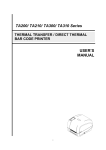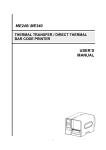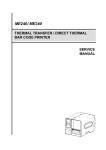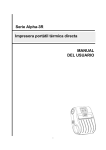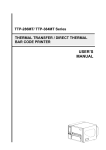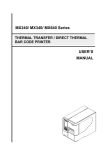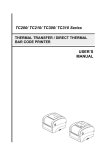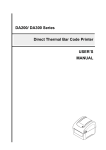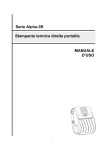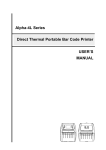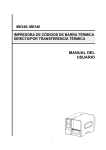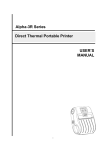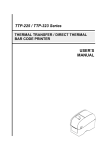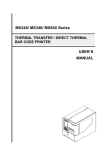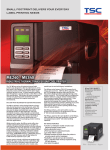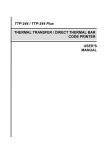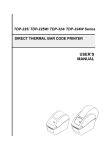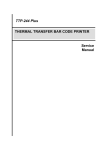Download USER'S MANUAL Alpha-3R Direct Thermal Portable Printer
Transcript
Alpha-3R Direct Thermal Portable Printer USER’S MANUAL i Copyright Information © 2012 TSC Auto ID Technology Co., Ltd, The copyright in this manual, the software and firmware in the printer described therein are owned by TSC Auto ID Technology Co., Ltd, All rights reserved. CG Triumvirate is a trademark of Agfa Corporation. CG Triumvirate Bold Condensed font is under license from the Monotype Corporation. Windows is a registered trademark of Microsoft Corporation. All other trademarks are the property of their respective owners. Information in this document is subject to change without notice and does not represent a commitment on the part of TSC Auto ID Technology Co. No part of this manual may be reproduced or transmitted in any form or by any means, for any purpose other than the purchaser’s personal use, without the expressed written permission of TSC Auto ID Technology Co. ii Agency Compliance and Approvals CE CLASS B EN 55022:2006 +A1:2007 EN 55024:1998+A1:2001+A2:2003 EN 61000-4 SERIES REQULATIONS FCC CFR Title 47 Part 15 Subpart B:2011 Class B ICES-003 Issue 4:2004 Class B Wichtige Sicherheits-Hinweise 1. Bitte lesen Sie diese Hinweis sorgfältig durch. 2. Heben Sie diese Anleitung fűr den späteren Gebrauch auf. 3. Vor jedem Reinigen ist das Gerät vom Stromentz zu trennen. Verwenden Sie keine Flüssig-oder Aerosolreiniger. Am besten eignet sich ein angefeuchtetes Tuch zur Reinigung. 4. Die Netzanschluß -Steckdose soll nahe dem Gerät angebracht und leicht zugänglich sein. 5. Das Gerät ist vor Feuchtigkeit zu schűtzen. 6. Bei der Aufstellung des Gerätes ist auf sicheren Stand zu achten. Ein Kippen oder Fallen könnte Beschädigungen hervorrufen. 7. Beachten Sie beim Anschluß ans Stromnetz die Anschluß werte. 8. Dieses Gerät kann bis zu einer Auß entemperatur von maximal 40℃ betrieben werden. Battery safety warning: DO NOT throw the battery in fire. DO NOT short circuit the contacts. DO NOT disassemble the battery. DO NOT throw the battery in municipal waste. The symbol of the crossed out wheeled bin indicates that the battery should not be placed in municipal waste. iii Class B: FEDERAL COMMUNICATIONS COMMISSION INTERFERENCE STATEMENT This equipment has been tested and found to comply with the limits for a Class B digital device, pursuant to part 15 of the FCC Rules. These limits are designed to provide reasonable protection against harmful interference in a residential installation. This equipment generates, uses and can radiate radio frequency energy and, if not installed and used in accordance with the instructions, may cause harmful interference to radio communications. However, there is no guarantee that interference will not occur in a particular installation. If this equipment does cause harmful interference to radio or television reception, which can be determined by turning the equipment off and on, the user is encouraged to try to correct the interference by one or more of the following measures: -Reorient or relocate the receiving antenna. -Increase the separation between the equipment and receiver. -Connect the equipment into an outlet on a circuit different from that to which the receiver is connected. -Consult the dealer or an experienced radio/ TV technician for help. CAUTION: Any changes or modifications not expressly approved by the grantee of this device could void the user's authority to operate the equipment. RF exposure warning (WiFi) This equipment must be installed and operated in accordance with provided instructions and must not be co-located or operating in conjunction with any other antenna or transmitter. End-users and installers must be providing with antenna installation instructions and transmitter operating conditions for satisfying RF exposure compliance. SAR Value: 0.023 W/kg RF exposure warning (For Bluetooth) The equipment complies with FCC RF exposure limits set forth for an uncontrolled environment. The equipment must not be co-located or operating in conjunction with any other antenna or transmitter. iv Canada, Industry Canada (IC) Notices This Class B digital apparatus complies with Canadian ICES-003 and RSS-210. Operation is subject to the following two conditions: (1) this device may not cause interference, and (2) this device must accept any interference, including interference that may cause undesired operation of the device. Radio Frequency (RF) Exposure Information The radiated output power of the Wireless Device is below the Industry Canada (IC) radio frequency exposure limits. The Wireless Device should be used in such a manner such that the potential for human contact during normal operation is minimized. This device has been evaluated for and shown compliant with the IC Specific Absorption Rate (“SAR”) limits when installed in specific host products operated in portable exposure conditions. (For WiFi) This device has also been evaluated and shown compliant with the IC RF Exposure limits under portable exposure conditions. (antennas are less than 20 cm of a person's body). (For Bluetooth) Canada, avis d'Industry Canada (IC) Cet appareil numérique de classe B est conforme aux normes canadiennes ICES-003 et RSS-210. Son fonctionnement est soumis aux deux conditions suivantes : (1) cet appareil ne doit pas causer d'interférence et (2) cet appareil doit accepter toute interférence, notamment les interférences qui peuvent affecter son fonctionnement. Informations concernant l'exposition aux fréquences radio (RF) La puissance de sortie émise par l’appareil de sans fil est inférieure à la limite d'exposition aux fréquences radio d'Industry Canada (IC). Utilisez l’appareil de sans fil de façon à minimiser les contacts humains lors du fonctionnement normal. Ce périphérique a été évalué et démontré conforme aux limites SAR (Specific Absorption Rate – Taux d'absorption spécifique) d'IC lorsqu'il est installé dans des produits hôtes particuliers qui fonctionnent dans des conditions d'exposition à des appareils portables. (For WiFi) v Ce périphérique a également été évalué et démontré conforme aux limites d'exposition aux RF d'IC dans des conditions d'exposition à des appareils portables. (les antennes sont moins de 20 cm du corps d'une personne). (For Bluetooth) vi Contents 1. Introduction ................................................. 1 1.1 Product Introduction ......................................................................................... 1 1.2 Product Features ............................................................................................... 2 1.2.1 Printer Standard Features ...................................................................... 2 1.2.2 Printer Optional Features ....................................................................... 3 1.3 General Specifications ...................................................................................... 3 1.4 Print Specifications ........................................................................................... 4 1.5 Media Specifications ......................................................................................... 4 2. Operations Overview .......................................... 5 2.1 Unpacking and Inspection ................................................................................ 5 2.2 Printer Overview ................................................................................................ 6 2.2.1 Front View ............................................................................................... 6 2.2.2 Interior View ............................................................................................ 7 2.2.3 Rear View ................................................................................................ 8 2.3 Operator control ................................................................................................ 9 2.3.1 LED Indication and Keys ........................................................................ 9 3. Setup ..................................................... 11 3.1 Install the Battery ............................................................................................ 11 3.2 Charge the Battery .......................................................................................... 12 3.2.1 Charge the Battery................................................................................ 12 3.2.2 Charge by Charger Station (Optional) ................................................. 13 3.2.3 Charge by Vehicle Power Adaptor (Optional) ..................................... 14 3.3 Communicate .................................................................................................. 15 3.3.2 Connecting with the Communication Cable ....................................... 15 3.3.2 Connecting with Bluetooth (Optional) ................................................. 16 3.4 Loading the Media ........................................................................................... 17 4. Accessories ................................................ 19 4.1 Install the Belt Clip ......................................................................................... 19 4.2 Install the IP54-rated environmental case with shoulder strap (Optional) .. 20 5. Power-on Utilities ........................................... 21 5.1 Black Mark Sensor Calibration ...................................................................... 21 5.2 Self-test and Dump Mode ............................................................................... 22 5.3 Printer Initialization ........................................................................................ 24 6. Diagnostic Tool ............................................. 26 6.1 Start the Diagnostic Tool ............................................................................... 26 vii 6.2 Printer Function .............................................................................................. 27 6.3 Calibrating Media Sensor by Diagnostic Tool .............................................. 28 6.3.1 Auto Calibration .................................................................................... 28 6.4 Setting Wi-Fi by Diagnostic Tool ................................................................... 29 6.5 Setting Bluetooth by Diagnostic Tool ........................................................... 30 7. Troubleshooting ............................................ 31 7.1 Common Problems ......................................................................................... 31 8. Maintenance ............................................... 33 Revise History ................................................ 34 viii 1. Introduction 1.1 Product Introduction Thank you very much for purchasing TSC bar code printer. Enjoy TSC’s reputation for cost-efficient, high durability printers with the Alpha-3R economical receipt printer. The Alpha-3R is a comfortable, light-weight printer capable of working with any mobile receipt printing application where you need quick, simple receipts on demand. Our Alpha-3R is designed for a rough life, inside the IP54-rated environmental case to resist dust and water and with its rubber over-mold design prepared to take up to a five foot fall and keep printing. These small and light printers can be worn comfortably for a full shift, without interfering with the user’s tasks. Use USB, or optional Bluetooth® , 802.11 b/g/n Wireless or Serial to connect to a mobile computer or even a smart phone and produce clear easy-to-read receipts hour after hour. This document provides an easy reference for operating the Alpha-3R. The online version of the Programmer's manual, or more information can be downloaded from service and support web site as an Adobe Acrobat Reader file. To print label formats, please refer to the instructions provided with your labeling software; if you need to write the custom programs, please refer to the TSPL/TSPL2 programming manual that can be found on the accessories CD-ROM or on TSC website at http://www.tscprinters.com Applications Direct store deliveries (DSD) Field repair/installation Mobile point of sale Parking citations Mobile ticketing Onboard transportation ticketing Utility billing/meter reading 1 1.2 Product Features 1.2.1 Printer Standard Features The printer offers the following standard features. Product standard feature Alpha-3R Direct thermal printing ○ Reflective sensor ○ Head open sensor ○ 3 operation buttons (On/off, feed, and cover-open) ○ 2 color LED for printer status, 3 LEDs for battery status ○ USB 2.0 (full speed) interface ○ 8 MB SDRAM memory ○ 4 MB FLASH memory ○ Powerful 32 bit 200 MHz RISC processor ○ Eltron® and Zebra® emulation languages support ○ Internal 8 alpha-numeric bitmap fonts ○ Fonts and bar codes can be printed in any one of the four directions (0, 90,180, 270 degree) ○ Internal Monotype Imaging® true type font engine with one CG Triumvirate Bold Condensed scalable font ○ Downloadable fonts from PC to printer memory ○ Downloadable firmware upgrades ○ Text, bar code, graphics/image printing (Please refer to the TSPL/TSPL2 programming manual for supporting code page) Supported bar code 1D bar code Code 39, Code 93, Code128UCC, Code128 subsets A,B,C, Codabar, Interleaved 2 of 5, EAN-8, EAN-13, EAN-128, UPC-A, UPC-E, EAN and UPC 2(5) digits add-on, MSI, PLESSEY, POSTNET, China POST, GS1 DataBar, Supported image 2D bar code PDF-417, Maxicode, DataMatrix, QR code, Aztec, BITMAP, BMP, PCX (Max. 256 colors graphics) 2 ○ 1.2.2 Printer Optional Features The printer offers the following optional features. Product option feature User Factory options options 802.11 b/g/n wireless ○ Bluetooth 2.0 ○ CPCL emulation ○ Black mark sensor position (left / right / center) ○ Charge station 1 cell (with changeable power connector) ○ Vehicle power adapter ○ IP54-rated environmental case with shoulder strap ○ USB to RS-232 cable ○ USB cable ○ Li-ion battery ○ 1.3 General Specifications General Specifications Physical dimensions 116 mm (W) x 148 mm (H) x 70 mm (D) Weight 550 g (1.21 lb) Electrical DC 7.4V/ 2500 mA/ h rechargeable battery Environmental condition Operation: -10 ~ 50˚C (32 ~ 104˚F), 10 ~ 90% non-condensing Storage: -40 ~ 60 ˚C (-40 ~ 140˚F), 10 ~ 99% non-condensing 3 1.4 Print Specifications Print Specifications Alpha-3R Print head resolution 203 dots/inch (8 dots/mm) Printing method Direct thermal Dot size (width x length) 0.125 x 0.125 mm (1 mm = 8 dots) Print speed (inches per second) 2, 3, 4 ips selectable Up to 4 ips Max. print width 72 mm (2.83”) Max. print length 2286 mm (90”) Vertical: 1 mm max. Printout bias Horizontal: 1 mm max. 1.5 Media Specifications Media Specifications Alpha-3R Media roll capacity 57 mm (2.25”) OD Media type Receipt paper Bline receipt paper (Black mark in printing side) Media wound type Printing face outside wound Max. 80 mm (3.15”) Media width Max. 38 m (125 ft) Media length Min. 21 m (69 ft) Max. 0.10 mm (4 mil) Media thickness Min. 0.05 mm (2 mil) Max. 19 mm (0.75”) Media core diameter Min. 10.2 mm (0.4”) 4 2. Operations Overview 2.1 Unpacking and Inspection This printer has been specially packaged to withstand damage during shipping. Please carefully inspect the packaging and printer upon receiving the bar code printer. Please retain the packaging materials in case you need to reship the printer. Unpacking the printer, the following items are included in the carton. One printer unit One Li-ion battery One Windows labeling software/Windows driver CD disk One quick installation guide One power adaptor If any parts are missing, please contact the Customer Service Department of your purchased reseller or distributor. 5 2.2 Printer Overview 2.2.1 Front View 1 2 3 4 5 6 1. LED indicator 2. Feed button 3. Power on/off button 4. Media cover release button 5. Media holder adjustment knob 6. Media cover 6 2.2.2 Interior View 1 2 3 5 4 1. Tear edge 2. Print head 3. Media holder 4. Platen 5. Black mark sensor 7 2.2.3 Rear View 1 2 3 4 5 1. Li-ion battery 2. Battery open clasp 3. USB interface 4. Power jack 5. Interface cover 8 2.3 Operator control 2.3.1 LED Indication and Keys 3 4 5 2 1 6 1. Power on/off button 2. Printer status LED indicator 3. Battery charge level LED indicator 4. Battery status LED indicator 5. Wireless status LED indicator 6. Feed button LED Printer status LED indicator Battery status LED indicator Battery charge level LED indicator Wireless status LED indicator Status Indication Off Pinter is ready Green (blinking) Printer is paused Red (solid) Media cover is open Red (blinking) Printer error Green (blinking) Recharge the battery Amber (solid) Battery is charging Full charged Green (solid) 2/3 charged level 1/3 charged level Blue (solid) Wireless device is ready Blue (blinking) Wireless device is communicating 9 Keys Function 1. Press and hold for 2-3 seconds to turn on the printer. 2. Press and hold for 2-3 seconds to turn off the printer. 1. Feed one label when printer is ready. 2. Pause the print gob while printing. 10 3. Setup 3.1 Install the Battery 1. Insert the left side to install the battery at the rear of the printer. 2. Push the right side of the battery. PUSH 3. Pull the battery clasp to lock the battery. Battery safety warning: DO NOT throw the battery in fire. DO NOT short circuit the contacts. DO NOT disassemble the battery. DO NOT throw the battery in municipal waste. The symbol of the crossed out wheeled bin indicates that the battery should not be placed in municipal waste. 11 3.2 Charge the Battery 3.2.1 Charge the Battery 1. Open the interface cover and plug the power cord to the power jack. 2. Plug the power cord into a properly power outlet. Note: Please switch OFF printer power prior to plug in the power cord to printer power jack. When the battery is charging, please do not remove the battery from the printer, otherwise, please re-plug the power cord into a power outlet. 3. When the battery is charging, the color of battery status LED indicator is solid amber. Note: When charging over 4 ~ 8 hrs, the battery is completely charged and the amber of LED indicator will be off. 12 3.2.2 Charge by Charger Station (Optional) 1. Plug the power cord to the power jack on the charger station. 2. Install the battery in the charger station. (Refer to steps on section 3.1) 3. Plug the power cord into a properly power outlet. LED Color Green / Solid Red / Solid Red / Blinking Off Description Battery is completely charged Battery is charging Battery charging error No battery Battery is completely charged over 4 ~ 8 hrs. 13 3.2.3 Charge by Vehicle Power Adaptor (Optional) 1. Open the interface cover and plug the power cord to the power jack. 2. Plug the vehicle power adaptor into the car cigarette lighter socket. Note: It takes 2 to 3 hours to fully charge the battery before the first time usage. The lifetime of the battery is 300 times for charge/discharge cycles. 14 3.3 Communicate 3.3.2 Connecting with the Communication Cable 3.3.1-1 USB to USB Cable (Optional) Open the interface cover and connect the printer to the computer with USB cable. USB interface USB connector (Printer) USB connector (PC) 3.3.1-2 USB to RS-232 Cable (Optional) Open the interface cover and connect the printer to the computer with RS-232 cable. RS-232 connector (PC) 15 3.3.2 Connecting with Bluetooth (Optional) Turn on the printer and make sure the Bluetooth of device is open. Default Name BT-SPP PIN 0000 Note: Please refer to section 6.5 to change the name of default and PIN. 16 3.4 Loading the Media Loading the Media Roll 1. Open the printer media cover by pressing the media cover release button. 2. Use a coin to rotate the media holder adjustment knob, and the media holder should be placed at the correct place to fit the media roll. Media holder Note: The media holder should be positioned overlap the bold line and remain the media holder alignment indicator visible. 3. 17 Place the media roll at the correct side, and pull out enough paper over the tear edge. 4. Press each side of media cover to close the media cover and make sure the media cover closed correctly. 18 4. Accessories 4.1 Install the Belt Clip 19 1. Refer to figure beside. Loop the belt clip through the slot below the battery. 2. Fasten the belt clip with 2 buttons. 3. The printer can be hung on the belt. 4.2 Install the IP54-rated environmental case with shoulder strap (Optional) 1. Open the case top cover. Top cover Outside cover 20 2. Put the printer into the case. 3. Close the case top cover. And the outside cover should be opened while printing. 5. Power-on Utilities There are three power-on utilities to set up and test printer hardware. These utilities are activated by pressing FEED button then turning on the printer power simultaneously and release the button at different positions of LED indicator. Please follow the steps below for different power-on utilities. 1. Turn off the printer power switch. 2. Hold on the button then turn on the power switch. 3. Release the button when LED indicates with different positions for different functions. Power on utilities The positions of LED light will be changed as following pattern: LED Functions 1. Black mark sensor (Solid) (5 blinks) (5 blinks) (5 blinks) (Solid green) Release calibration 2. Self-test and enter dump Release mode 3. Printer initialization Release 5.1 Black Mark Sensor Calibration Black mark sensor sensitivity should be calibrated at the following conditions: 1. A brand new printer 2. Change media roll 3. Printer initialization Please follow the steps below to calibrate the black mark sensor. 1. Turn off the power switch. 2. Hold on the button then turn on the power switch. 3. Release the button when the indicator becomes will do during the 5 blinks) 21 and blinking. (Any green It will calibrate the black mark sensor sensitivity. The LEDs will be changed as following order: (amber) (5 blinks) (5 blinks) (solid green) (5 blinks) 5.2 Self-test and Dump Mode While calibrate the black mark sensor, printer will measure the media length, print the internal configuration (self-test) on media and then enter the dump mode. To calibrate black mark sensor, depends on the sensor setting in the last print job. Please follow the steps below to calibrate the sensor. 1. Turn off the power switch. 2. Hold on the button then turn on the power switch. 3. Release the button when the indicator becomes will do during the 5 blinks) and blinking. (Any green The LEDs will be changed as following order: (amber) (5 blinks) (5 blinks) (solid green) (5 blinks) 4. It calibrates the sensor and measures the media length and prints internal settings then enter the dump mode. 22 Self-test Printer will print the printer configuration after black mark sensor calibration. Self-test printout can be used to check if there is any dot damage on the heater element, printer configurations and available memory space. Printer model name & Main board firmware version Printer serial number Printed mileage Main board firmware checksum Serial port setting Code page Country code Print speed Print darkness Label size (width, height) Black mark (vertical gap, offset) Sensor sensitivity Battery voltage Print head temperature Print head average resistance Bad dots of print head Bluetooth settings information (option) File management information Print head test pattern 23 Dump mode Printer will enter dump mode after printing printer configuration. In the dump mode, all characters will be printed in 2 columns as following. The left side characters are received from your system and right side data are the corresponding hexadecimal value of the characters. It allows users or engineers to verify and debug the program. Hex decimal data related to left ASCII Data column of ASCII data Note: 1. Dump mode requires 3” wide paper width. 2. Turn off / on the power to resume printer for normal printing. 5.3 Printer Initialization Printer initialization is used to clear DRAM and restore printer settings to defaults. Printer initialization is activated by the following procedures. 1. Turn off the power switch. 2. Hold on the button then turn on the power switch. 3. Release the button when the indicator becomes and blinking. (Any green will do during the 5 blinks). The LEDs will be changed as following: (amber) (5 blinks) (5 blinks) (solid green) 24 (5 blinks) Printer configuration will be restored to defaults as below after initialization. Parameter Default setting Speed 50.8 mm/sec (2 ips) Density 8 Media Width 2.83” (72 mm) Media Height 4” (101.5 mm) Sensor Type Black mark sensor (As paper end sensor) Black Mark Setting As paper end sensor Print Direction 0 Reference Point 0,0 (upper left corner) Offset 0 Serial Port Settings 9600 bps, none parity, 8 data bits, 1 stop bit Code Page 850 Country Code 001 Clear Flash Memory No IP Address DHCP 25 6. Diagnostic Tool TSC’s Diagnostic Utility is an integrated tool incorporating features that enable you to explore a printer’s settings/status; change a printer’s settings; download graphics, fonts and firmware; create a printer bitmap font; and send additional commands to a printer. With the aid of this powerful tool, you can review printer status and settings in an instant, which makes it much easier to troubleshoot problems and other issues. 6.1 Start the Diagnostic Tool 1. Double click on the Diagnostic tool icon to start the software. 2. There are four features (Printer Configuration, File Manager, Bitmap Font Manager, Command Tool) included in the Diagnostic utility. Features tab Interface Printer functions Printer setup Printer Status 26 6.2 Printer Function 1. Select the PC interface connected with bar code printer. 2 1 The default interface setting is USB interface. If USB interface is connected with printer, no other settings need to be changed in the interface field. 2. Click the “Printer Function” button to setup. 3. The detail functions in the Printer Function Group are listed as below. Function Description Calibrate the sensor specified in the Printer Setup group media sensor field Setup the IP address, subnet mask, gateway for the on board Ethernet Calibrate Sensor Ethernet Setup RTC Setup Synchronize printer Real Time Clock with PC Factory Default Initialize the printer and restore the settings to factory default. (Please refer section 5.3) Reset Printer Reboot printer Print Test Page Print a test page Configuration Page Print printer configuration (Please refer section 5.2) Dump Text To activate the printer dump mode. Ignore AUTO.BAS Ignore the downloaded AUTO.BAS program Exit Line Mode Exit line mode. Password Setup Set the password to protect the settings For more information about Diagnostic Tool, please refer to the diagnostic utility quick start guide in the CD disk \ Utilities directory. 27 6.3 Calibrating Media Sensor by Diagnostic Tool 6.3.1 Auto Calibration 1. Make sure the media is installed ready and media cover is closed. (Please refer to section 3.4) 2. Turn on the printer power switch. 3. Open Diagnostic tool and set interface. (The default setting is USB) 2 1 The default interface setting is USB interface. If USB interface is connected with printer, no other settings need to be changed in the interface field. 4. Click the “Calibrate Sensor” button. 5. Select the media type and click the “Calibrate” button. 1 2 Note: The Alpha-3R can only support back mark and continuous of media type. 28 6.4 Setting Wi-Fi by Diagnostic Tool 1. Make sure the media is installed ready and media cover is closed. (Please refer to section 3.4) 2. Turn on the printer power switch. 3. Open Diagnostic tool and set interface. (The default setting is USB) 2 1 The default interface setting is USB interface. If USB interface is connected with printer, no other settings need to be changed in the interface field. 4. Select “interface” and set WLAN SSID, WLAN Encryption, and WLAN Key. 5. Press “Set” button. 6. Press “Get” button to make sure WLAN is set properly. 1 2 3 4 Note: The printer connects with the computer via USB cable or RS-232 cable, which are option. Diagnostic tool higher than V1.47 and the firmware higher than V1.22 can support this function. 29 6.5 Setting Bluetooth by Diagnostic Tool 1. Make sure the media is installed ready and media cover is closed. (Please refer to section 3.4) 2. Turn on the printer power switch. 3. Open Diagnostic tool and set interface. (The default setting is USB) 2 1 The default interface setting is USB interface. If USB interface is connected with printer, no other settings need to be changed in the interface field. 4. Select internal and set BT Local Name and BT PIN Code. 5. Press “Set” to set the new BT name and BT PIN code of the printer. 1 2 3 Note: The printer connects with the computer via USB cable or RS-232 cable, which are option. Diagnostic tool higher than V1.47 and the firmware higher than V1.22 can support this function. 30 7. Troubleshooting 7.1 Common Problems The following guide lists the most common problems that may be encountered when operating this bar code printer. If the printer still does not function after all suggested solutions have been invoked, please contact the Customer Service Department of your purchased reseller or distributor for assistance. Problem Power indicator does not illuminate Possible Cause Recovery Procedure * The battery is not properly installed. * The battery is dead. * Reinstall the battery. * Switch the printer on. * Charge the battery. * The printer carriage is open. * Please close the print carriage. * Running out of media roll. * The media is installed incorrectly. * Black mark sensor is not calibrated. * Supply a new media roll. * Please refer to the steps on section 3.4 to reinstall the media roll. * Calibrate the black mark sensor. - The printer status from DiagTool shows “Head Open”. - The printer status from DiagTool shows “Out of Paper”.. * Black mark sensor is not set properly. - The printer status from * Make sure media size is set DiagTool shows “Paper Jam”. properly. * Media may be stuck inside the printer mechanism. Memory full ( FLASH / DRAM ) Poor Print Quality * The space of FLASH/DRAM is full. * Media is loaded incorrectly * Dust or adhesive accumulation on the print head. * Print density is not set properly. * Printhead element is damaged. 31 * Calibrate the black mark sensor. * Set media size correctly. * Delete unused files in the FLASH/DRAM. * The max. numbers of DRAM is 256 files. * The max. user addressable memory space of DRAM is 256KB. * The max. numbers of file of FLASH is 256 files. * The max. user addressable memory space of FLASH is 2560KB. * Reload the supply. * Clean the print head. * Clean the platen roller. * Adjust the print density and print speed. * Run printer self-test and check the print head test pattern if there is dot missing in the pattern. * Change proper media roll. Missing printing on the left or * Wrong label size setup. * Set the correct label size. right side of label * Re-connect cable to interface. * If using serial cable, - Please replace the cable with pin to pin connected. - Check the baud rate setting. The default baud rate setting of printer is 9600,n,8,1. * If using the Ethernet cable, - Check if the Ethernet RJ-45 connector green LED is lit on. - Check if the Ethernet RJ-45 connector amber LED is blinking. * Cable is not well connected to - Check if the printer gets the IP address when using DHCP mode. USB interface. Check if the IP address is correct when * The serial port cable pin Not Printing using the static IP address. configuration is not pin to pin Wait a few seconds let the printer get the connected. communication with the server then check the IP address setting again. * Chang a new cable. * Clean the print head. * The print density setting is incorrect. * Print head’s harness connector is not well connected with printheat. Turn off the printer and plug the connector again. * Check your program if there is a command PRINT at the end of the file and there must have CRLF at the end of each command line. * The print head is dirty. * Clean the print head. Gray line on the blank label * The platen roller is dirty. * Clean the platen roller. * The printer is in Hex Dump * Turn off and on the printer to skip the mode. dump mode. Irregular printing * The RS-232 setting is * Re-set the Rs-232 setting. incorrect. 32 8. Maintenance This session presents the clean tools and methods to maintain your printer. 1. Please use one of following material to clean the printer. Cotton swab Lint-free cloth Vacuum / Blower brush 100% Ethanol or Isopropyl Alcohol 2. The cleaning process is described as following, Printer Part Method 1. Always turn off the printer before cleaning the print head. 2. Allow the print head to cool for a minimum of one minute. 3. Use a cotton swab and 100% Ethanol or Isopropyl Alcohol to clean the print head surface. Interval Clean the print head when changing a new label roll Print Head 1. Turn the power off. 2. Rotate the platen roller and wipe it Platen Roller thoroughly with 100% ethanol and a cotton swab, or lint-free cloth. Use the lint-free cloth with 100% Tear Bar/Peel Bar ethanol to wipe it. Compressed air or vacuum Sensor Wipe it with water-dampened cloth Exterior Interior Brush or vacuum Clean the platen roller when changing a new label roll As needed Monthly As needed As needed Note: Do not touch printer head by hand. If you touch it careless, please use ethanol to clean it. Please use 100% Ethenol or Isopropyl Alcohol. DO NOT use medical alcohol, which may damage the printer head. Regularly clean the print head and supply sensors once change a new ribbon to keep printer performance and extend printer life. 33 Revise History Date Content 34 Editor TSC Auto ID Technology Co., Ltd. Corporate Headquarters 9F., No.95, Minquan Rd., Xindian Dist., New Taipei City 23141, Taiwan (R.O.C.) TEL: +886-2-2218-6789 FAX: +886-2-2218-5678 Web site: www.tscprinters.com E-mail: printer_sales@tscprinters.com tech_support@tscprinters.com 35 Li Ze Plant No.35, Sec. 2, Ligong 1st Rd., Wujie Township, Yilan County 26841, Taiwan (R.O.C.) TEL: +886-3-990-6677 FAX: +886-3-990-5577











































